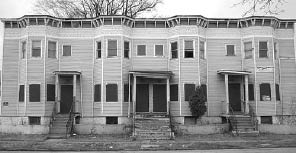Home Improvement
by Daniel B. Honigman

For a city in dire need of a unique selling point, the Woodlawn Row houses on Woodlawn Avenue represent a perfect example of a fix-it-up opportunity for Buffalo, and a chance to help improve its image.
Built in 1894, the Woodlawn Houses are one of only three examples left in Buffalo of the row house design, a traditional form of urban architecture. Known for their sturdiness as well as the ability to blend seamlessly into city streetscapes, row houses are seen in many metropolitan cities all over the world.
The houses, located on 147-153 Woodlawn Avenue, are no secret. Or are they?
Granted “Local Landmark” status by the Buffalo Preservation Board in 1981 and owned by the City of Buffalo since 2002, the edifices have been victimized by deterioration, vandalism and more than a century of frigid Buffalo winters. Some local residents are surprised that the houses are, in fact, for sale.
This negligence is almost tragic, according to Clinton Brown, a local architect and preservation activist. Brown believes that the current state of maintenance is subpar, especially when one considers the architectural and historic significance of the houses:
“[The Woodlawn Row Houses] represent an important kind of housing that was attempted in Buffalo at all levels, whether at the elite level on Delaware, or as more affordable [housing] for growing families on the East side,” said Brown.
It’s not as if the city has no reason to upgrade the property. Several large-scale development plans are in the works for the Masten District, including the 110,000-square-foot Artspace project, slated for construction in the near future.
In addition, the Buffalo Traditional High School, located at 450 Masten Street, is a centerpiece of the $1 billion schools reconstruction project, coordinated by LP Ciminelli. The school is scheduled for renovation and conversion into the Buffalo Academy for Visual and Performing Arts (BAVPA) in June.
The school is a mere 50 or so paces across the street from the decaying Woodlawn houses.
“In the Phase 1 [Ciminelli] projects, there have been a ton of dollars pumped into the community, but nothing is done in the area around the schools,” said Dave Torke, local resident and site administrator for the Fix Buffalo Today for Tomorrow blog (www.fixbuffalo.blogspot.com).
According to community activist Michele Johnson, while saving the Woodlawn houses should be a concern, she acknowledges the fact that the city may not have enough in its piggy bank to save them:
“I really would have a problem tearing them down, because there are so few row houses left. They are something of our past that we should try to preserve, even though [the city doesn’t] have the money to preserve everything,” said Johnson. “I do believe, however, that while there are some things we have to save, we have to be selective.”
Why would anyone want to pony up the tens of thousands of dollars necessary to revamp the houses? According to Torke, who fixed up and now lives in a similar set of houses not far away on Woodlawn Avenue, the rewards can be immeasurable:
“It’s important to adaptively reuse [these] buildings. It puts us in touch with our community, and there’s something about reusable buildings that helps us make connections with the past,” said Torke.
At this point, Drew Kelley, president of the BAVPA Parent Teacher Organization, would just like to see something get done:
“I’d like to see them get either fixed up or bulldozed, one way or the other, but they look like they have a lot of potential,” said Kelley. “It’s important that the neighborhoods don’t look like war zones around the schools, that’s for sure.”
|
Issue Navigation> Issue Index > v5n11: Street Smarts (3/16/06) > Street Smarts > Home Improvement This Week's Issue • Artvoice Daily • Artvoice TV • Events Calendar • Classifieds |









 Current Issue
Current Issue